
|
You entered: terrain
 Searching for Meteorites in Antarctica
Searching for Meteorites in Antarctica
26.12.2002
Where is the best place on Earth to find meteorites? Although meteors fall all over the world, they usually just sink to the bottom of an ocean, are buried by shifting terrain, or are easily confused with terrestrial rocks.
 A Landing at Meridiani Planum
A Landing at Meridiani Planum
26.01.2004
After an interplanetary journey of nearly 300 million miles, Opportunity bounced down on the martian surface at about 9:05 pm PST Saturday, its final plunge cushioned by airbags. Now the second NASA rover...
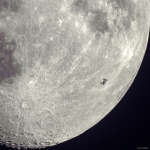 Space Station Silhouette on the Moon
Space Station Silhouette on the Moon
2.04.2019
What's that unusual spot on the Moon? It's the International Space Station. Using precise timing, the Earth-orbiting space platform was photographed in front of a partially lit gibbous Moon last month. The featured image was taken from Palo Alto, California, USA with an exposure time of only 1/667 of a second.
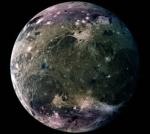 Ganymede Mosaic
Ganymede Mosaic
4.03.1999
Ganymede, one of the four Galilean moons of Jupiter, is the largest moon in the Solar System. With a diameter of 5,260 kilometers it is even larger than planets Mercury and Pluto and just over three quarters the size of Mars. Ganymede is locked in synchronous rotation with Jupiter.
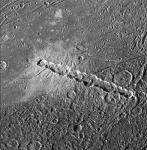 Ganymede: Torn Comet Crater Chain
Ganymede: Torn Comet Crater Chain
5.08.1998
This remarkable line of 13 closely spaced craters on Jupiter's moon Ganymede was photographed by the Galileo spacecraft in 1997. The picture covers an area about 120 miles wide and the chain of craters cuts across a sharp boundary between dark and light terrain. What caused this crater chain?
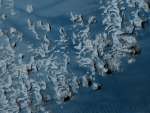 Layers in Aureum Chaos
Layers in Aureum Chaos
4.04.2008
At first glance these undulating shapes in shades of blue might look like waves on an ocean. Seen here in a false-color image from the Mars Reconnaissance Orbiter's HiRISE camera, they are actually layered rock outcrops found in Aureum Chaos.
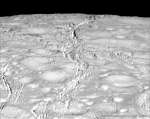 The Fractured North Pole of Saturns Enceladus
The Fractured North Pole of Saturns Enceladus
21.10.2015
The north pole of Saturn's moon Enceladus is unexpectedly fascinating and complex. Previous to the latest flyby of the robotic Cassini spacecraft, the northern region was known mostly for its unusually high abundance of craters.
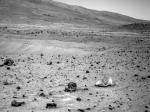 An Unusual Two Toned Rock on Mars
An Unusual Two Toned Rock on Mars
26.01.2006
How did this unusual Martian rock form? The atypical two-toned rock, visible in the lower right of the above image, was photographed a few days ago by the robotic Spirit rover currently rolling across Mars. For now, the environmental processes that created the rock remain a matter of speculation.
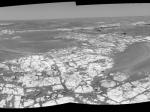 The Road to Victoria Crater on Mars
The Road to Victoria Crater on Mars
5.06.2006
Here is a road never traveled. To get to Victoria Crater on Mars, the rolling robotic rover Opportunity must traverse the landscape shown above. Victoria Crater lies about one kilometer ahead. The intervening terrain shows a series of light rock outcrops that appears like some sort of cobblestone road.
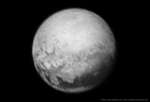 APOD: 2015 July 11 Geology on Pluto
APOD: 2015 July 11 Geology on Pluto
11.07.2015
Pluto is coming into focus. As the robotic New Horizons spacecraft bears down on this unexplored world of the distant Solar System, new features on its surface are becoming evident. In the displayed image...
|
January February March April May |
|||||||||||||||||||||||||||||||||||||||||||||||||